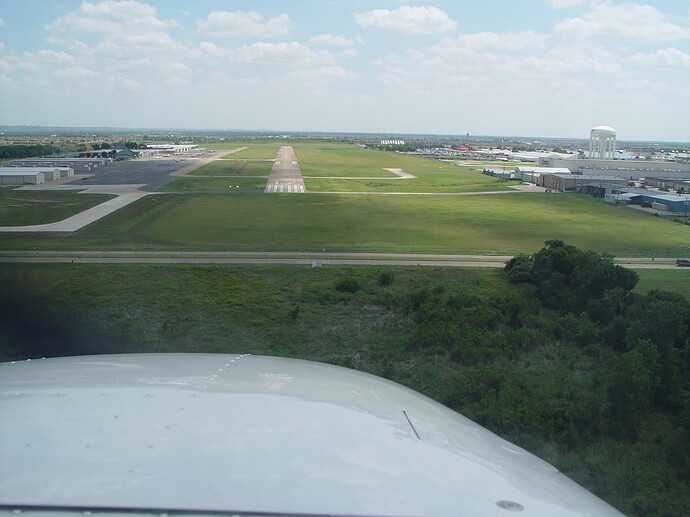Na… a bird flys faster than a 152… at minimum a 172!
Joking aside, since the devs added the fluid dynamics physics to the 152 a few upgrades back, it flys more realistically, imho, than any other default ac.
Instead of apples/oranges, I’m thinking it’s more like tangerines and oranges - similar, but different. With the two instruments, they’re both left hand on the neck and right hand on the bow. Compare that to most planes being left hand on the yoke and right hand on the throttle quadrant. Different planes may take different skills, but the overall concept is the same. Just keep at it, and you’ll get there.
One of the best things about learning the pattern with a 152 or a 172 are the wing struts. On downwind…center the runway on the strut…it’s a perfect way to keep the runway parallel to you and space yourself from the runway at 1000’ AGL!
I’m going to have to try the changed sim 152. Last time I kept wanting to wing walk outside and add a few more turns on the rubber band!
Learning is so interesting and complex. I played viola once and would told you I knew nothing about a cello, because it physically was different…making it appear totally different.
Seems my observation over years as the learning of anything involves the technical act of executing the learning ( which is simple to observe) and the backgroup prep work that may be a very shared learned between these players. How to read music, how to follow the conductor, what to do when you make a mistake, how to be in tune and adjust tuning when needed, how to take care of the instrument. What resin to use and right and wrong ways to use it.
See what I mean? All that paragraph lists skills that these kids learned, and non musical kids havent learned. I think if the violin player developed a desperate desire to switch to cello, it would 100 times faster to master than a non musical kid. Its change they resist, not a difficult learning path.
@FlyingsCool5650 If you were to do it yourself, how far away will you be in the downwind portion of the pattern keeping in mind that you’re in a fast jet and mountains are on the way and could obstruct your view. You might not see the airport if you’re too far away also. If you’re too high because you are avoiding the mountains, you might have too much speed descending to the base leg.
I’ve tried it several times descending from 2500 -3000 ft on the downwind leg (over the mountains) but that results in my overshooting the final leg.
@EcstaticRock92 I basically agree with you about change and how learning is easy (to some anyway). The challenge is being good at what has been learned. That’s the difficult part: doing the practice hours to be good enough to play music or landing a jet without crashing to the ground.

@C182golf You write well. Your description of the pattern was well written and I enjoyed reading it. Thank you.
Longitude is a different beast entirely. You could fly a VFR pattern there, but your minimum approach speed is around 170-180 kts, which means things happen Really Really Fast on approach.
If you really want to fly that, I would open up the off-sets and aim to join the Downwind just after where you would have entered it after the Cross-Wind leg. You can’t really use the wing-offset trick here, as you’re so far forward you can’t judge it using that rule of thumb. I would plan to try for a 0.5 NM offset while running parallel, and wait a full 20 seconds after the down-wind end passes out of your left FOV. You’re moving a LOT faster than a typical 70-80 kt approach in a prop GA, so you need trade distance for time to get set up. The turn to base and then final is fairly big, so buy more time by increasing your distances and getting slower, but not so slow that you stall out.
Pro-Tip: Spoilers are safely deployable at 210 kts or lower, so don’t be afraid to use them for auxiliary speed control - don’t get low AND slow in this jet - turbojets do not spool up immediately, meaning your thrust response is a little slower for large inputs and you will stall in with no altitude to recover - instantly fatal. Auto-Throttle is also your friend - set it to 170 kts for Base and Final and use Spoilers to slow as you approach the Threshold. Remember to disengage A/T and pull back the power as your mains touch, full spoilers at that point and then reverse thrusters, and pulse not lock up the wheel brakes to prevent a ground loop. Keybinds to A/T, Spoiler Deployment and mapping your Throttles to engage Reverse Thrust are very helpful as things happen quickly.
Thanks!
I actually became a real pilot because of flight simulator. Just passing on what I have learned to help all of us fly better and safer…be it simulated or real.
This is what it should look like on short final…Red over White…your alright!
Picture is in my 172sp (before I got instrument rated) that I traded for my current 182T
Back then when you purchased a new Cessna aircraft, they paid for your next rating as part of the deal!
For my local airport I use certain landmarks to know where I am and once in the turn I pay attention to my bank angle … However I’ve just recently adopted Aruco head tracking (it’s free) which certainly does make it much easier for maintaining visual contact from my all glass glider cockpit.
Ah yes. Many a breakfast I’ve had at the Midfield Cafe. ![]()
Covid took it’s toll on many of the fly in diners…but they are slowly coming back.
Looks like that NH fly in restaurant survived. I miss my favorite at T67 Hicks field…was 5 stars in the hundred dollar hamburger book. Rio Concho.
Our whole series of training tutorials were inspired by those old FS2000 and onwards lessons. I remember having the certificates printed out and completed by my sister as she had neater handwriting.
We cover VFR, Navigation, IFR and Jetliner flying, designed on my own experiences of training to be an airline Captain.
David
FS ACADEMY
@CasualClick Thank you for the informative post.
I’ve been practicing the final using 130-140 kts in MSFS. Btw, I don’t think there is a speed limit on the Longitude spoilers.
Real life video below (not me):
is that available on Xbox?
1 mile = 5280 Feet - Think of it that way and double the length of the runway. You’re pretty close depending on how elevated you are AGL. Use the PAPI or VASI lights for the Glideslope and I was taught when getting my private license White over White you can fly all night. Red over Red You’re dead. PAPI you want 2 white(Left)/ 2 Red(Right) - For VASI You want 2 red on the top and 2 white on the bottom for the correct glideslope - Both of these systems should be easily visible from about 4-5 miles away if you are within range AGL
If you want a good challenging airport for the plane you are using, once you get better at landings try 46U Alpine coming in over the mountains. You can practice that all day long. Citation Max has a great video of it and it inspired me to make some scenery for that airport - You can see how he lines up his approach watching this video: Flying Into a Private Mountain Airport Community! - YouTube
